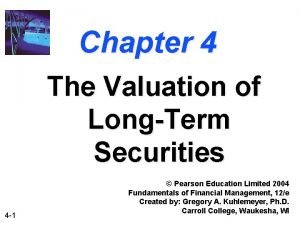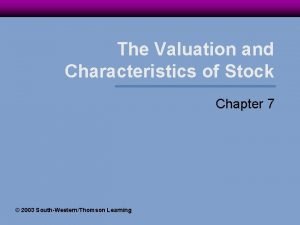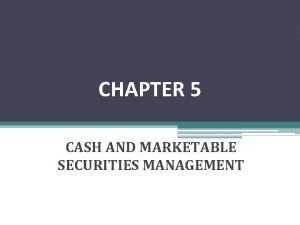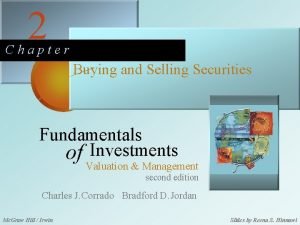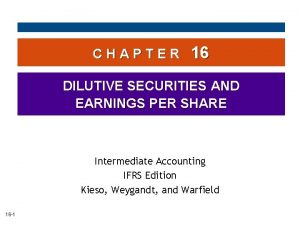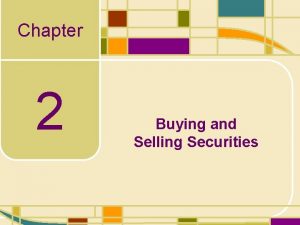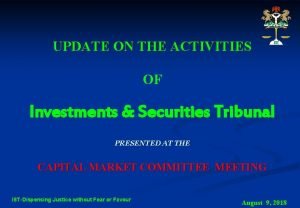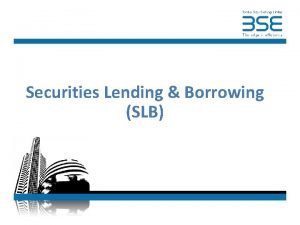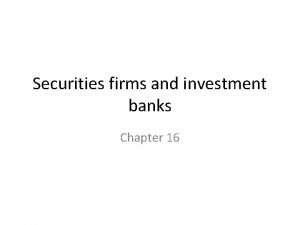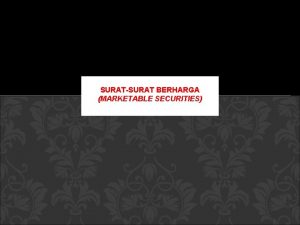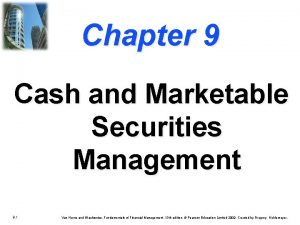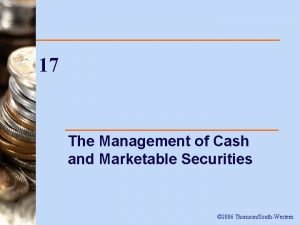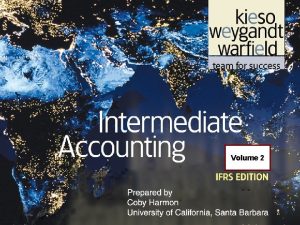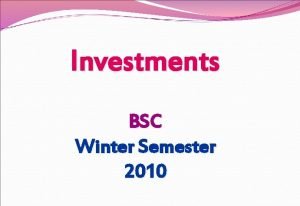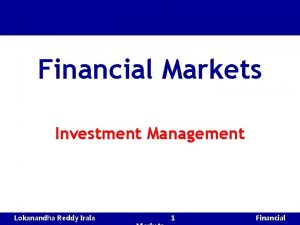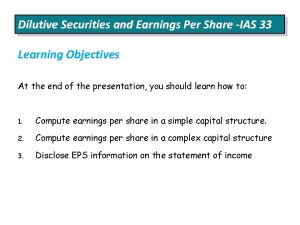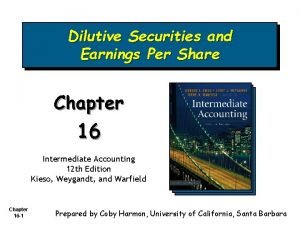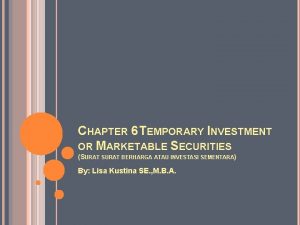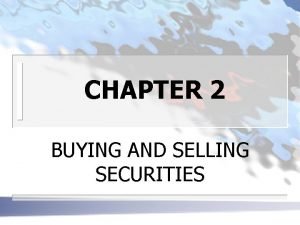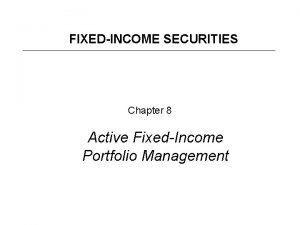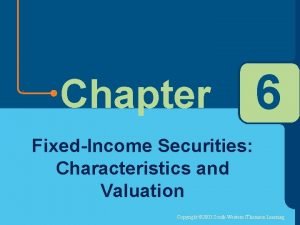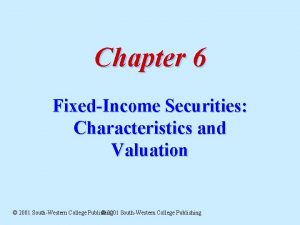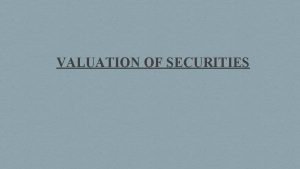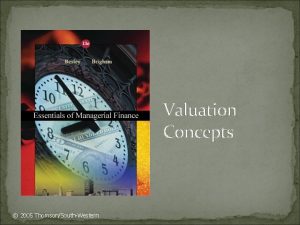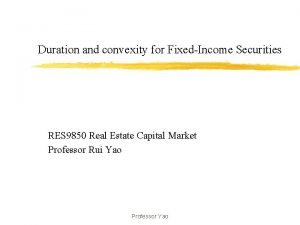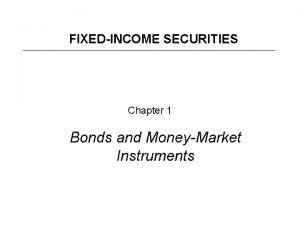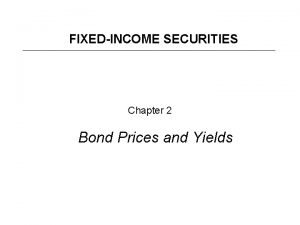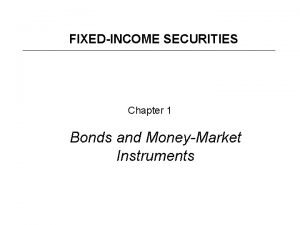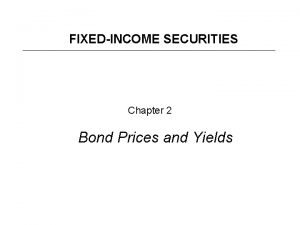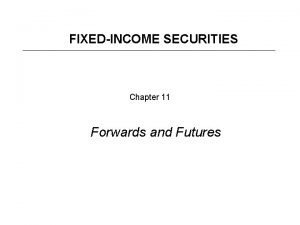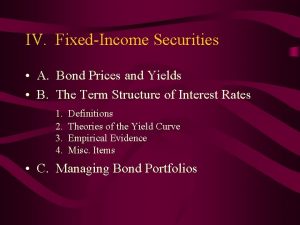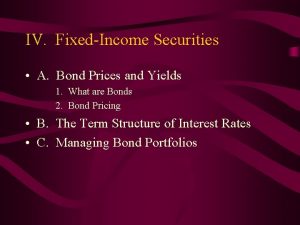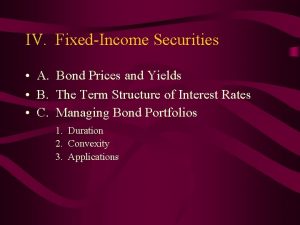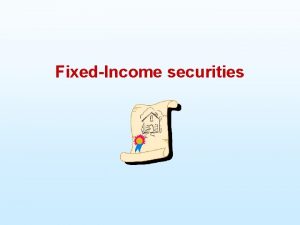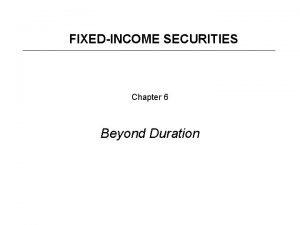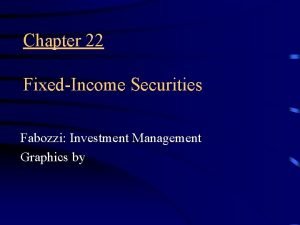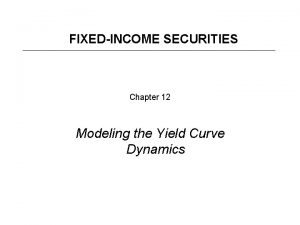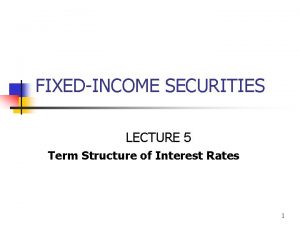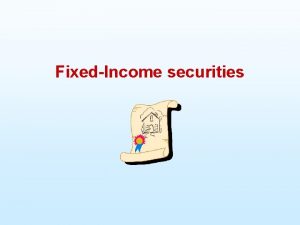7 FixedIncome Securities Characteristics and Valuation 2006 ThomsonSouthWestern


























- Slides: 26

7 Fixed-Income Securities: Characteristics and Valuation © 2006 Thomson/South-Western

Introduction n This chapter focuses on the characteristics and valuation of fixedincome securities. q Long-term debt q Preferred stock 2

Classification of Long-Term (L-T) Debt n Mortgage bonds secured n Debentures unsecured q Subordinated and unsubordinated n Claims of subordinated debenture holders are considered only after the claims of unsubordinated debt holders 3

Types of L-T Debt n Equipment trust certificates n Income bonds n Collateral trust bonds n Pollution control bonds n Industrial revenue bonds 4

Characteristics of L-T Debt n Indenture q n covenants n Sinking fund n Equity-linked debt Trustee q TIA 1939 q convertible q warrant n Call feature n Coupon rates n Call premium n Size $25–$200 million 5

Corporate bonds n Market for corporate bonds q q n Majority traded in the over-the-counter market Some larger issues traded on the NY Exchange Quotations percent of par value $1000 Duke. En 63/8 08 6. 8 40 93¾ – 1/4 n Meaning a Duke Energy bond with an interest rate (coupon rate) of 6. 375 percent, maturing in 2008, yielding 6. 8 percent, $40, 000 dollars traded, closing price of $930. 75, down $2. 50 from the previous day. Current information: http: //www. etrade. com/ 6

U. S. Government Debt Securities n U. S. Treasury bills q q q n Maturities of 3, 6, and 12 months Minimum denominations of $10, 000 Sold at a discount from maturity value Treasury notes and bonds q q S-T L-T Notes 1– 10 year maturity Bonds 10– 30 year maturity 7

Bond Ratings Quality S & P’s Moody’s Highest AAA Aaa High AA Aa Upper Medium A A Medium BBB Baa Junk BB, B, CCC, Ba, B, Caa, C C D Default http: //www. standardandpoors. com/ http: //www. moodys. com/ 8

Ratings n Higher rated bonds generally carry lower market yields. n Interest rate spread between ratings is less during prosperity than during recessions. n Junk bonds typically yield 3– 6 percent or more. 9

International Bonds n Eurobonds q q n Issued outside of the issuer’s country Denominated in the home currency May have less regulatory interference May have less disclosure requirements Foreign bonds are issued in a single foreign country with interest and principal paid in that foreign currency. 10

Value of an Asset Based on the expected future benefits over the life of the asset n Future benefits = cash flows (CFs) • Capitalization of cash flow method n – PV of the stream of future benefits discounted at an appropriate required rate of return 11

Market Value of an Asset n Market price n Equilibrium n Demand & Supply (D&S) n D&S Intersection n Consensus Judgment n Approximated value 12

13

The Value of a Bond is the Present Value of its Cash Flows 14

15

Bond Prices and Interest Rates n Relationship between P 0 and kd q n There is an inverse relationship between a bond’s value, P 0, and its required rate of return, kd. L-T vs. S-T Bonds q A change in kd changes the value of a long-term bond more than the value of a short-term bond. 16

17

Yield to maturity of a bond If the price is known, you can solve for the value of kd which is the yield to maturity on the bond (the yield that makes the present value of the promised cash flows equal to the market price of the bond. 18

Perpetual Bond A perpetual bond pays $I forever— the value of a perpetual bond is computed as: 19

Zero Coupon Bonds formula table 20

21

Ethical Issue n In many leveraged buyouts (LBOs), the buyer of the firm financed the purchase with a large amount of debt. n Often, stockholders made a large gain while bond prices plummeted because of the higher leverage the firm has assumed. 22

Preferred Stock (P/S) n n n Is in an intermediate position between C/S and LT debt Part of equity while increasing financial leverage Dividends on P/S are not tax deductible. Has preference over C/S with regard to earnings and assets Dividends can not be paid on C/S unless the preferred dividend for the period has been paid. 23

Characteristics of P/S n Selling price n Participation n Par value n Maturity n Adjusted rate P/S n Call feature n Cumulative n Voting rights 24

P/S Advantages and Disadvantages n Advantages q Flexible q Can increase financial leverage q Corporate tax advantage n Disadvantages q High after-tax cost q Dividends are not tax deductible 25

Value of P/S A share of preferred stock pays $I forever —the value of a preferred share is computed as: 26
 Fixed income securities
Fixed income securities Valuation of fixed income securities
Valuation of fixed income securities Valuation of long term securities
Valuation of long term securities Characteristics of stock valuation
Characteristics of stock valuation Management of cash and marketable securities
Management of cash and marketable securities Buying and selling securities
Buying and selling securities Cisi introduction to securities and investment
Cisi introduction to securities and investment Basic earnings per share
Basic earnings per share Buying and selling of securities
Buying and selling of securities Cash and marketable securities
Cash and marketable securities Investment and securities tribunal
Investment and securities tribunal Sds group security
Sds group security Securities lending and borrowing example
Securities lending and borrowing example What are the functions of securities firms
What are the functions of securities firms Cash and marketable securities management
Cash and marketable securities management Cash and marketable securities management
Cash and marketable securities management Cash and securities management
Cash and securities management Dilutive securities
Dilutive securities Chapter 6 lesson 2 guided reading answers
Chapter 6 lesson 2 guided reading answers Non marketable securities
Non marketable securities Ilss club
Ilss club Non marketable securities
Non marketable securities Dilutive securities
Dilutive securities Dilutive securities
Dilutive securities Reverse convertible bonds
Reverse convertible bonds Marketable securities adalah
Marketable securities adalah Securities definition
Securities definition


